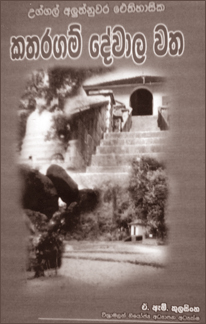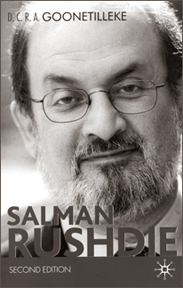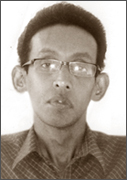|

Research of religious value
Reviewed by Amal Hewavissenthi
The important research conducted by the author into the historic and
religious background of Katharagama Devale of Uggal Aluthnuwara is
indeed commendable.
 The
Devale, the writer says is located in picturesque landscape in
Aluthnuwara on the Colombo - Badulla main road. According to the writer,
its history dates back to over six centuries. The
Devale, the writer says is located in picturesque landscape in
Aluthnuwara on the Colombo - Badulla main road. According to the writer,
its history dates back to over six centuries.
The writer is of the view that research so far conducted on the
Devale has focused only on rituals and beliefs though there are other
vital aspects such as its origin, social atmosphere, and the folk
society associated with it.
The book graphically explains the development of the Devale, its
range of land, the impressive moments and rituals of Perahera and the
historical value of ancient writings (Sannasas) connected to it.
The writer takes pride in illustrating practically all the aspects of
the Devale which are a source of inspiration to the people of
Aluthnuwara. However, the book attributes the concept of Devale to that
of Hindu Kovils, that flourished with added Buddhist traits enjoying
royal patronage since ancient times. Devales erected to pay homage to
Hindu gods such as Natha, Saman, Vishnu, Vibhushana and Katharagama
began to blend gradually with the Buddhist traditions and Sinhala
culture.
The writer has made use to a vast spectrum of source to revivify the
past splendour. The Devale throughout its history has commanded respect
and awe of its devotees.
"Though many scholars have dealt with certain dimensions of the
Devale, a more complete compendium with the full details, has been a
much felt need" says Kulasinghe in his author's note.
The writer relates interesting anecdote about a tusker brought to the
Devale for Perahera. "Those days the person in charge of elephant used
to take it to the river called Denagamoya for bath.
One day the mahout having brought the tusker to water drank some
toddy but under intoxication he lay down on the sand and fell asleep.
His sleep lasted till late in the afternoon and the tusker came out
of water at the usual time. The tusker holding the man on his two tusks,
came to the Devale to the utter fright of the people who were running
away for life.
The man awoke on the way and remained motionless on the tusks because
he had sensed no possible deliberate injury from the tusker. People had
at first been scared that the tusker was bringing dead body of his
master who was assumed to have been killed while bathing in the river.
The tusker finally kept the man softly on the step leading to Devale.
When people finally got to know about the wonderful moral intents of
the tusker, they prepared Kevum and milk rice and fed the elephant.."
The above is only one of many interesting legends associated with the
Devale.
The writer presents his creation in simple and clear language.
He deserves full credit for preserving the vital information relating
the history of Uggal Aluthnuwara Devale which could have been buried
with the passage of time.
Essentials of language teaching and learning
***
Reviewed by Chandima H. de Silva,
Senior Lecturer, University of Kelaniya
Book: Foundations in Language Learning
Author: Dr. Neelakshi Chandrasena Premawardhena
***
Foundations in Language Learning by Dr. Neelakshi Chandrasena
Premawardhena of the Department of Modern Languages, University of
Kelaniya is a result of the author's two decades of teaching German at
University level and much research on teaching foreign languages.
On the one hand, this is a textbook for the discerning learner of
languages and a treatise for language teachers on the other. To the best
of my knowledge, no single publication in Sri Lanka to-date has covered
so many salient aspects of language teaching and learning.
Learning a new language opens doors to a whole new world. Adjusting
to new speech sounds, sentence structures and even new writing systems
is not an easy task for an adult learner.
Moreover, familiarizing oneself with the culture and lifestyle of
native speakers of the target language is so essential to understand the
nuances of everyday speech.
The author, in her remarkable book comprising 14 chapters, has dealt
with so many aspects of language teaching and learning, hitherto not
discussed by an academic in a single publication.
In addition to being a University teacher in German language for two
decades, Dr. Premawardhena's academic training in linguistics has added
value to her book. Contents of her book can be effectively used and put
into practice not only by German language teachers/learners but by any
teacher/learner of any foreign language, including English. I am no
expert in language teaching.
However, I do strongly believe that even English language teaching in
Sri Lanka, both in secondary and tertiary education, could benefit from
certain aspects presented in Dr. Premawardhena's book.
Foundations in Language Learning consists of interesting discussions
on Functions of Language, Some aspects of Linguistics, Verbal and
non-verbal Communication, Human Communication, Animal Communication,
Language and Culture, Intercultural Communication, Unique and Universal
Features of Languages, Aspects of Language Teaching, Second and Foreign
Language Acquisition, Testing and Measurement, Effective Language
Teaching and Interactive Computer Aided Language Learning.
The emphasis of the book is more on practical aspects rather than on
theoretical underpinnings, with an aim to provide useful hints to
understand local learners in a better manner and design language lessons
that could produce effective results.
It is interesting to note how Dr. Premawardhena provides authentic
examples from local sources to support almost all topics related to
language teaching and learning presented in her book.
This, I am sure, would motivate teachers of foreign languages in Sri
Lanka to further explore the veritable mine of local information and
sources readily available but often unused in teaching and learning.
The chapter on animal communication is very interesting as it
provides a lot of well researched information, perhaps hitherto unknown
to many Sri Lankan readers. Can animals talk?, animals using human
language, the case of an untrained domestic parrot, studies on cognitive
abilities of animals and studies on animal communication are some topics
discussed here.
The author then identifies unique features of human communication.
She hastens to mention that linguists differ in their opinion in
unanimously accepting features of human communication and provides seven
features that most linguists seem to accept.
The chapter on Introduction to Linguistics aims to present certain
areas of study that helps oneself to embark on a scientific study of
language.
The author believes that at least a basic understanding of
linguistics is essential to become a good language teacher and this
particular chapter directs the discerning reader as to what areas of
linguistics are more important for a teacher.
To my mind, the two most important chapters in this book deal with
Language and Culture and Intercultural Communication.
At a time when several international conferences are held every year
on these areas, it is perhaps the first time that a book published in
Sri Lanka provides insights into these two very important paradigms in
language teaching and learning. Learning a new language always opens
doors to a new culture and due to diversity in different cultures, a
language learner is compelled to understand the unwritten rules of the
target language.
The author emphasizes the importance of learning the culture of the
speakers of the target language by providing very interesting real world
examples.Furthermore, Dr. Premawardhena provides references to studies
and research done on given areas throughout her book.
It is commendable that a very comprehensive bibliography is given at
the end of the book to enable the reader further study and research.
Two chapters on Aspects of Language Teaching and Effective Language
Teaching are invaluable to language teachers, both in secondary and
tertiary education.
The role of Linguists and Applied Linguists, First and Second
Language Acquisition, Second and Foreign Language Teaching Methodology,
Purpose of Second or Foreign Language Learning,
First and Second Language Interference, Motivating students,
Understanding the learner, Planning a lesson, Addressing the four skills
of language competency Testing and evaluation in language teaching and
Attributes of a good language teacher are some topics discussed in these
two chapters.
Interactive Computer Aided Language Learning is discussed in another
chapter. References to certain research done by the author are given
here while topics such as Addressing the language skills, Learner
autonomy, Enhanced performance and motivation are presented here.
The author's lucid writing makes reading Foundations in Language
Learning a pleasurable experience, even to a non-subject specialist like
myself.
Ample examples that reflect the Sri Lankan culture attracts the
attention of any local reader.
Foundations in Language Learning by Dr. Neelakshi Chandrasena
Premawardhena, a senior academic from the Department of Modern
Languages, University of Kelaniya (the only such Department offering
seven foreign languages in the entire Sri Lankan University system) is
an important addition to the literature in language teaching and
learning.
This book, I am sure, convinces the discerning language learner that
isolating language learning to mere achieving of grammatical and lexical
competency is insufficient to one's expected goal of mastering a
language.
More importantly, this book provides enough motivation, insight,
techniques and advice to any language teacher to become an able,
effective and an inspiring teacher and, as I know, Dr. Neelakshi
Premawardhena is an excellent virtuoso herself.
Met. Department sheds more light on lightning
by Prabuddha Athukorala and Kamalanath Liyanage
It's during this period of the year that everyone is in anticipation
of the rains, battered by weeks of harsh, energy sapping weather
conditions. More often than not Mother Nature has been kind enough to
greet Sri Lankans with inter- monsoon rains during the latter part of
March and April.
The same cannot be said about this year though. Apart from Ratnapura
all the other areas in the island have received below average rainfall.
Deputy Director of the Meteorological Department for Weather
Forecasting and Disaster Management Activities - S.R. Jayasekara, said
in the coming weeks, there is a high possibility that the sleeping rain
gods will wake up once again. Naturally, most of us would welcome this
change. Yet, there is the possibility of evening thunderstorms and
lightning.
The intensity of lightning will be far less this year around,
Jayasekara added. But we can never write off the threat of lightning
as it is one of the leading weather-related causes of death, injuries
and property damage. A harmonic lightning pattern can be observed in Sri
Lanka throughout the year. Mainly during April the lightning incidents
drastically increase compared to other months and are popularly known
among the people as "Bakmaha Akunu".
Formation
If we understood the mechanism behind the lightning it could help us
to take precautions.
Especially during the inter-monsoon period high daytime temperature
lead air particles closer to ground to rise. At higher atmosphere,
generally around 10-12 kilometres from the ground due to cooling
effects, the air particles will turn into packets filled with moisture
and form clouds.
Out of these clouds some become unstable and these are the cause for
thunderstorms.
These are also called `convective' showers. Lightning is caused when
ice and water particles in the clouds rub together during the
thunderstorm and discharge an electrical charge.
The Deputy Director said that the strength of the lightning depends
on the behaviour of the Inter Tropical Conversion Zone (ITCZ). With the
arrival of ITCZ to Sri Lanka around April 20. according to
Meteorological Department the country is at great lightning risk. This
phenomena is expected to affect Sri Lankan land mass up to mid of May.
The energy released from lightning strike can be enormous.
Current flashes
Domestic power circuits carry electricity around 15 Amperes. During a
lightning strike current flashes as high as 30000 Amperes are recorded.
Thus you can imagine the devastating effect.
Normally the areas mostly affected by lightning lie in the south
western region of the central slopes. Akmeemana, Deniyaya and Matugama
are some of the areas which have reported lightning incidents during the
past few weeks.
It's always advisable to be safe than sorry. Jayasekara said most Sri
Lankans are aware of safety measure but they lack seriousness about the
threat lightning poses.
Some of the precautionary steps are:
1.Keep electrical instruments disconnected from the main power
supply.
2.Television antennas should be disconnected from the television sets
3.Find shelter in a safe place to avoid exposing yourself to the open
air
4.Try to avoid loitering in open areas
5.Do not seek shelter under or near isolated tall trees and in high
grounds.
6.Limit the use of telephones when a thunderstorm is overhead.
Additionally, it is advisable to install proper lightning arrestors
in households which often get affected by lightning.
Contrary to what some would believe, there is no danger in touching,
holding or carrying a person struck by lightning.
The Body should be massaged to treat in case of temporary paralysis
due to lighting strikes.
If respiration is disturbed, artificial respiration should be tried
by blowing air into the patient's body through the mouth. In many cases,
massage and artificial respiration have to be given simultaneously.
Media contribution
Media organizations play a huge role in notifying the public about
thunderstorm threats.
With the developments in the media industry over the past decade,
deaths related to lightning have been vastly reduced. Figures speak for
themselves.
The Meteorological Department records show that back in 1997 there
were as many as 49 lightning related deaths and gradually this figure
has come down. In 2009 the figure was only 14 and this year we can
expect even fewer casualties.
Future of prediction systems
At present The Meteorological department is equipped with the latest
technologies and satellite images to issue weather predictions to the
general public, three times a day.
Also warnings are sent to sea going vessels and with the newly
established centre at the airport, managing turbulent weather conditions
has become much easier.
The Met Department is going to introduce a system which will help
eliminate thunderstorm threats even further. With the new system a
report will be circulated daily indicating most lightning prone areas in
Sri Lanka in the form of an intensity map, Jayasekara said. Furthermore,
with the commissioning of modern devices such as the Doppler radar in
Gongala area the team expects to give far more accurate predictions.
Hence, as our knowledge about the lightning risks increase and with
advancement in weather predictions systems, soon a day will come when we
can precisely pinpoint when and where t lightning will strike next.
But nature will always find a way to outsmart man. So, beware of
lightning.
[New on the Shelf]
Salman Rushdie: Second edition
D.C.R.A. Goonetilleke, Salman Rushdie: Second
Edition (London & New York: Palgrave Macmillan, 2010)
 `A
valuable and thorough reading of a major contemporary novelist's
writing.' `A
valuable and thorough reading of a major contemporary novelist's
writing.'
-Professor Randy Boyagoda, Ryerson University, Canada
Salman Rushdie is one of the most widely-studied and controversial
contemporary British authors.
This revised and expanded new edition of an established text explores
all of Rushdie's fiction, non-fiction and biographical writings to date.
Considering the author's fiction as art, in all its richness of
significance and technique, D.C.R.A. Goonetilleke examines the blend of
autobiographical and historical elements and analyses Rushdie's complex
position as a migrant writer.
Salman Rushdie, Second Edition: features new chapters which discuss
the author's most recent novels, including Fury (2001), Shalimar the
Clown (2005) and The Enchantress of Florence (2008) reviews Rushdie's
texts in the light of recent research and critical developments focuses
on Rushdie as a novelist in the context of migration, postcolonialism
and globalisation covers the 'Rushdie Affair', indicating that the
situation surrounding
The Satanic Verses is more intricate than simply 'freedom of
expression versus Islamic fundamentalism' contains an updated
Bibliography and helpful new Chronology to aid study.
In surveying Rushdie's complicated writing career and the innovative
and, later, 'popular' nature of his art, Professor Goonetilleke provides
fresh and original readings of all of the writer's work.
This lucid and approachable study is an essential introduction to
Salman Rushdie, rendering a notoriously 'difficult' author accessible to
students, scholars and general readers alike.
D.C.R.A. Goonetilleke is Emeritus Professor of English at the
University of Kelaniya, and has also held various academic posts in the
UK and Europe.
He is a well-established critic of twentieth-century and postcolonial
literature, and the leading authority on Sri Lankan English Literature.
[ Book launch]
 |
Sinhala Usage of the Twentieth Century: a
Sociolinguistic Study and A Dictionary of Sinhala Spelling (3rd
edition) - written by Dr. Sandagomi Coperahewa, a Senior
Lecturer, Department of Sinhala, University of Colombo, will be
launched on 0 March 30, at 3.30 p.m. at the Sri Lanka National
Library and Documentation Services Board Auditorium,
Independence Avenue, Colombo 7. Prof.r Emeritus K.N.O.
Dharmadasa will preside on the occasion and Prof. Asanga
Tilakaratna, Dr. Ashoka Premaratne and Chintaka Ranasinghe will
make short presentations. It is organised by Godage Bookshop.
|
|

